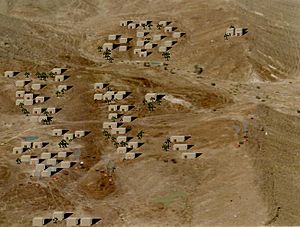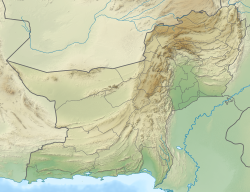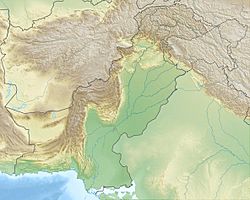Sokhta Koh facts for kids

Computer-aided reconstruction of coastal Harappan settlement at Sokhta Koh near Pasni
|
|
| Alternative name | Sotkakoh |
|---|---|
| Location | Balochistan, Pakistan |
| Region | Makran |
| Coordinates | 25°18′0″N 63°25′0″E / 25.30000°N 63.41667°E |
| Type | Settlement |
| History | |
| Cultures | Indus Valley civilization |
Sokhta Koh, also known as Sotka Koh, means "burnt hill." It is an ancient site from the Harappan civilization. You can find it on the Makran coast, close to the city of Pasni in the Balochistan province of Pakistan.
An American archaeologist named George F. Dales first explored this site in 1960. He was looking at river mouths along the Makran coast. Sokhta Koh is about 15 miles north of Pasni. Another similar Harappan site, Sutkagan Dor, is about 48 km inland, near the Dasht River. Both sites being near the coast suggests that the Harappan people traded by sea. Based on the types of pottery found, experts believe this settlement was active between 2600 and 1900 BC.
Contents
What Does Sokhta Koh Look Like?
Sokhta Koh is located on low hills in the Shadi Kaur river valley. It is surrounded by rocky hills north of Pasni. The river flows right next to the site today, and you can see old riverbeds nearby. Small streams, mostly filled by rainwater, flow into the Shadi Kaur. The area is quite dry.
How Big is the Ancient Settlement?
The hills themselves stretch for about two miles. However, the ancient settlement is smaller, covering less than a mile. It is hard to see the buildings from the ground because not much stands out. Only a few small digs have happened here, so most of the site has not been fully explored.
Dry ditches mark the northern and southern edges of the site. You can also see many old outdoor ovens buried under rocks. Interestingly, there are no clear signs that the settlement had strong walls for protection.
What Buildings Were There?
Since not much digging has been done, we don't know a lot about the buildings. However, in some places, the weather has worn away the ground, showing parts of old rooms. These rooms had bases made of layered rock, with walls built from mud or mud-bricks on top.
Why Mud Walls?
The people here didn't use baked bricks, even though they were good at making pottery. This suggests that there wasn't much rainfall, so mud walls were safe from getting washed away. Also, the settlement was built on hills, which probably protected it from river floods. From an aerial view, you can clearly see the rectangular shapes of room foundations. They were even lined up with the main compass directions (north, south, east, west).
What About Their Pottery?
The site is covered with thousands of broken pieces of pottery. These are all that's left of the old settlement. You can also see many outdoor ovens where they fired the pottery. It seems like they made a lot of pottery here. Perhaps it was used to pack goods that they traded for other valuable items.
Types of Pottery Found
The pottery pieces are from kiln-baked items like jars, plates, colanders (bowls with holes), and lids with handles. There are also fine clay pieces shaped like bangles. The pottery was made on a potter's wheel and is mostly pink, with some buff (light yellow-brown) colored pieces. Some jars have a reddish shiny band around the neck.
The designs on the pottery are only black. They are simple geometric shapes, like straight lines, fish scale patterns, circles that cross each other, comb-like patterns, and wavy lines. You won't find any pictures of people or animals on this pottery. Some jars and pots have "potter's marks" on their rims.
What Else Did They Find?
So far, no toys, seals, statues, or jewelry have been found at the top layers of the site. This suggests that the people here might have focused more on practical things. More digging might uncover other items that show more about their daily life and culture.
Why Was Sokhta Koh Left Empty?
Sokhta Koh might have been abandoned because the coastline changed. This could have happened for a few reasons:
- The land slowly or suddenly rose up.
- Mud and silt built up in the Shadi Kaur river delta.
- Sand built up on the beach and in the river mouth from wave action.
There are signs of another settlement closer to the sea, at the mouth of the Shadi Kaur river. This suggests that the people might have moved there after the harbor at Sokhta Koh dried up. Future excavations will try to find this new harbor and the source of wood they used for firing so much pottery.
Why Was Sokhta Koh Important for Trade?
Sokhta Koh was likely a key trading post. Ancient civilizations often traded to get "luxury goods," raw materials, and other items they couldn't find in their own areas. For the Indus Valley Civilization, these items included copper, gold, silver, tin, and various types of stones like jasper and carnelian. They also sought lapis lazuli, shells, and ivory.
Trading Routes and Shells
Experts believe that people traveled to distant areas to get these goods. One study looked at marine shells from India found at faraway sites in Iran and the Indus Valley. This shows how ancient trade routes worked. For example, a specific type of shell called Xancus pyrum was traded whole. It was then shaped into jewelry or other items at its destination. This shell is very important because it only comes from certain parts of the Indian coast. Finding it elsewhere helps us figure out ancient trade paths.
There were a few possible ways these shells could have traveled from the Indian coast to the west:
- By sea directly to the Iranian coast.
- By sea to sites like Sutkagen-dor and Sokhta Koh on the Makran coast, then overland.
- Overland through the Indus plain and then through the Makran interior.
- Overland through the Indus Valley and then through the Gomal Valley.
See also
- List of Indus Valley Civilization sites
- Sutkagan Dor
- Indus Valley Civilization
- Lothal
Images for kids





